How to Choose the Right Asphalt Mixture for Your Project in Troy, NY
To select the optimal asphalt mixture for your undertaking in Troy, NY, begin by assessing your specific project parameters. Key considerations should include the regional climate conditions, anticipated traffic levels, and requisite performance characteristics.
For areas subject to heavy vehicular use and warmer weather conditions, Hot Mix Asphalt (HMA) proves ideal. Conversely, Warm Mix Asphalt (WMA) presents an eco-friendly alternative that is effective under varied temperatures.
For routes with minimal traffic, Cold Mix Asphalt (CMA) offers a viable solution. Prioritize sustainability and financial implications in your decision-making process.
Explore distinct asphalt variants, such as Stone Matrix Asphalt (SMA) and Porous Asphalt, each providing unique benefits tailored to different requirements. By carefully choosing the right asphalt mix, you ensure the creation of a robust and enduring pavement infrastructure.
Benefits of Different Asphalt Mixes
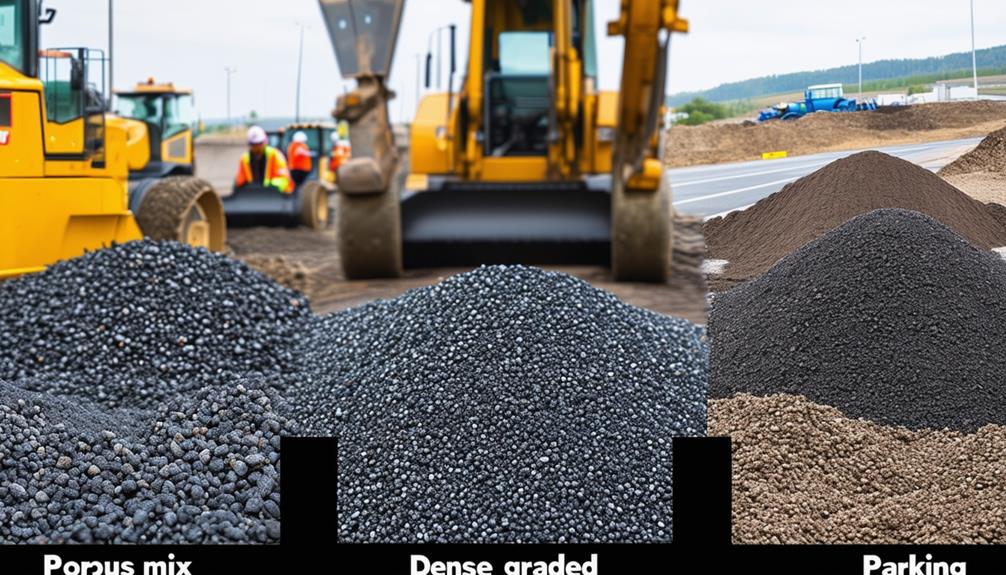
When selecting the appropriate asphalt mixture for your project in Troy, NY, comprehending the advantages of each variant is essential for achieving a successful and cost-effective result. Different asphalt formulations cater to distinct performance demands and adapt to local climatic conditions.
For example, Hot Mix Asphalt (HMA) is prized for its robust durability and is optimally designed for warm climates and high-traffic scenarios. It's applied at high temperatures ranging between 280 and 325 degrees Fahrenheit, which facilitates a strong and resilient pavement structure.
Warm Mix Asphalt (WMA) presents an eco-friendly alternative. With its manufacturing temperatures spanning from 200 to 250 degrees Fahrenheit, WMA notably reduces emissions and enhances moisture management, making it an excellent choice during the cooler seasons and for projects requiring minimal traffic disruptions.
On the other hand, Cold Mix Asphalt (CMA) is recommended for less frequented surfaces and provisional repairs. Applied at ambient temperatures, this mix necessitates minimal groundwork and proves to be more cost-efficient for smaller-scale endeavors.
Types and Uses of Asphalt
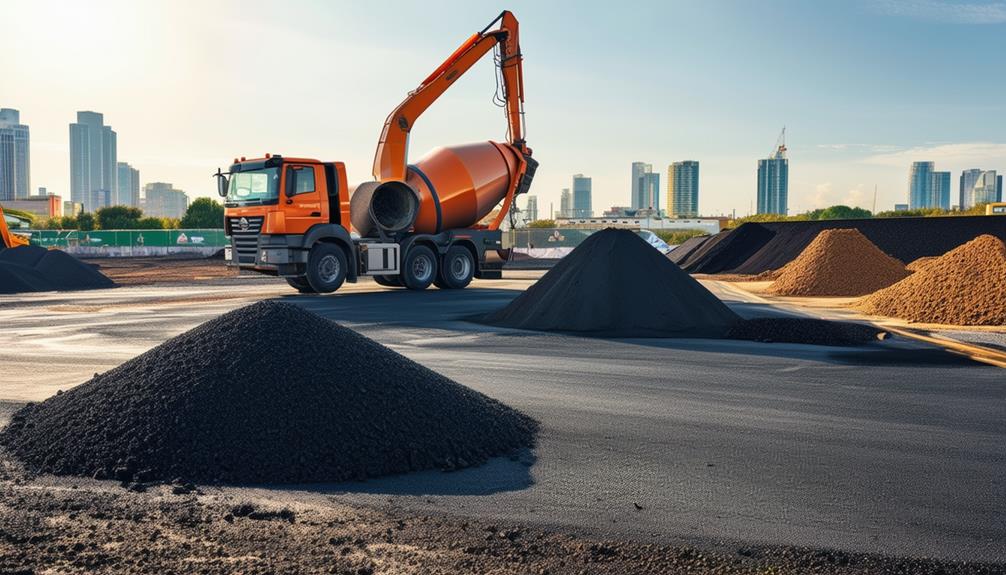
As you explore the world of asphalt, comprehending the various types is critical for selecting the appropriate mix for your concrete needs. Determining the specific requirements of your construction endeavor will assist you in choosing among Hot Mix Asphalt (HMA), Warm Mix Asphalt (WMA), and Cold Mix Asphalt (CMA).
Hot Mix Asphalt (HMA) emerges as the preferred option for constructing robust pavements during warmer climate periods. Applied at temperatures between 280-325°F, HMA delivers outstanding durability and is commonly chosen by construction experts for its capacity to endure significant vehicular load.
Alternately, WMA is produced at decreased temperatures of 200-250°F, serving as an eco-conscious choice that diminishes harmful emissions. WMA provides a compromise between performance and reduced operational temperatures, rendering it ideal for colder environments.
Conversely, Cold Mix Asphalt (CMA) offers a versatile and temperature-tolerant formulation, making it perfect for mendings such as filling potholes and conducting patchwork on roads with lighter traffic volumes. Although initially less resilient, advancements in CMA technology have enhanced its effectiveness, making it a viable option for minor roadway upkeep.
Climate and Performance Requirements
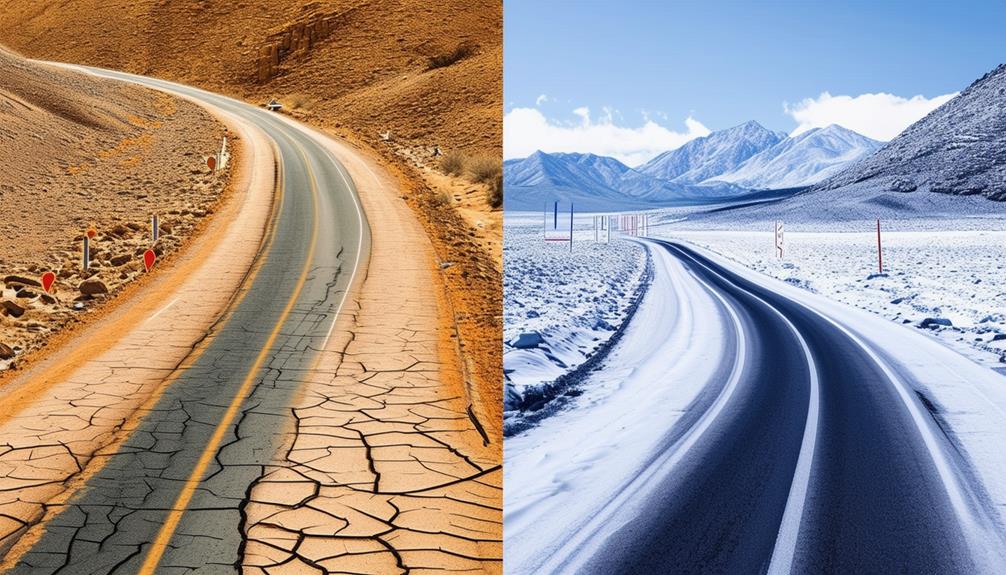
Climate and Performance Requirements
To guarantee the durability of asphalt in Troy, NY, it's crucial to consider how the local climate impacts the efficacy of your selected asphalt composition. In the colder environments typical of Troy, an asphalt composition that's robust against cracking from freeze-thaw cycles is necessary. Modified asphalt formulations, known for enhancing flexibility and resistance, are optimal for these rigorous performance requirements.
When choosing the appropriate asphalt mixture for your endeavor in Troy, NY, factors such as temperature fluctuations, precipitation levels, and freeze-thaw cycles should be meticulously evaluated. These climatic elements markedly affect the functionality and longevity of your asphalt infrastructure.
For example, a mixture that offers high skid resistance is vital in areas frequently experiencing rainfall; similarly, a mixture designed for high durability is indispensable for thoroughfares subject to intense vehicular traffic.
It is imperative to customize your asphalt mixture to not only meet but exceed the project performance standards while also navigating budgetary limitations to discover cost-effective solutions. By achieving this, you can ensure that your asphalt infrastructure withstands the local climatic conditions of Troy, thereby enhancing the freedom and mobility integral to your project's success.
Factors Influencing Asphalt Choice
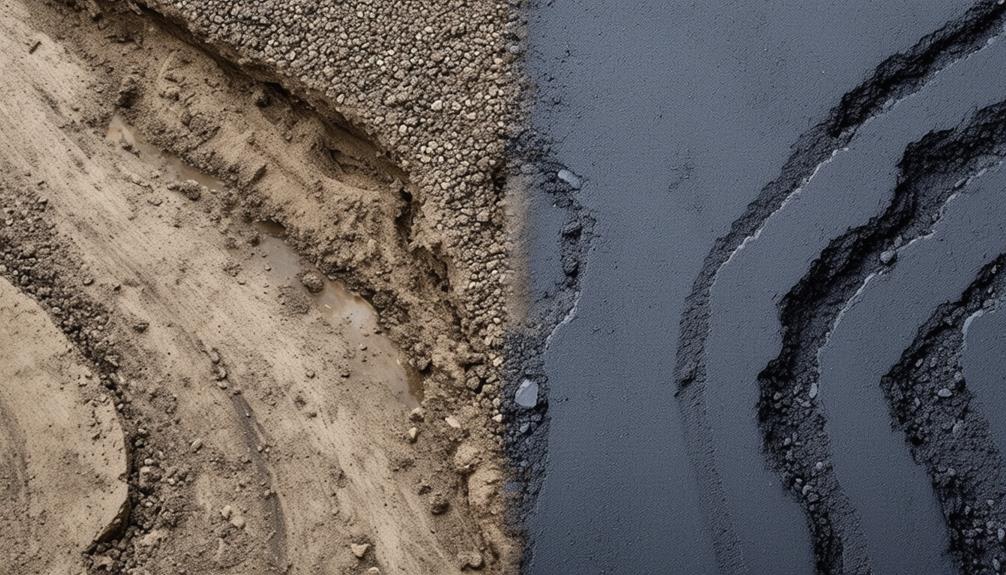
Selecting the Optimal Asphalt Composition for Construction Projects in Troy, NY: Critical Determinants Impacting Asphalt Selection
When choosing the appropriate asphalt mixture for any construction endeavor in Troy, NY, several critical elements must be considered to pinpoint the most suitable asphalt blend. Factors such as traffic density, local climatic conditions, and budgetary constraints are essential in ensuring the asphalt pavement meets the specific requirements of the project and maintains its integrity over time.
The climate of a region has a pronounced impact on the choice of asphalt, influencing the pavement's longevity. Additionally, the volume of traffic is a primary factor, as areas with higher vehicle traffic demand a robust mixture capable of enduring continuous wear and tear.
Factors such as regional environmental conditions are crucial; locations experiencing severe weather conditions necessitate an asphalt mix with an optimal binder content that promotes flexibility and crack resistance. Furthermore, the availability and quality of local materials play a fundamental role in influencing the durability and performance of the asphalt mix used in construction projects.
Sustainability in Asphalt Selection
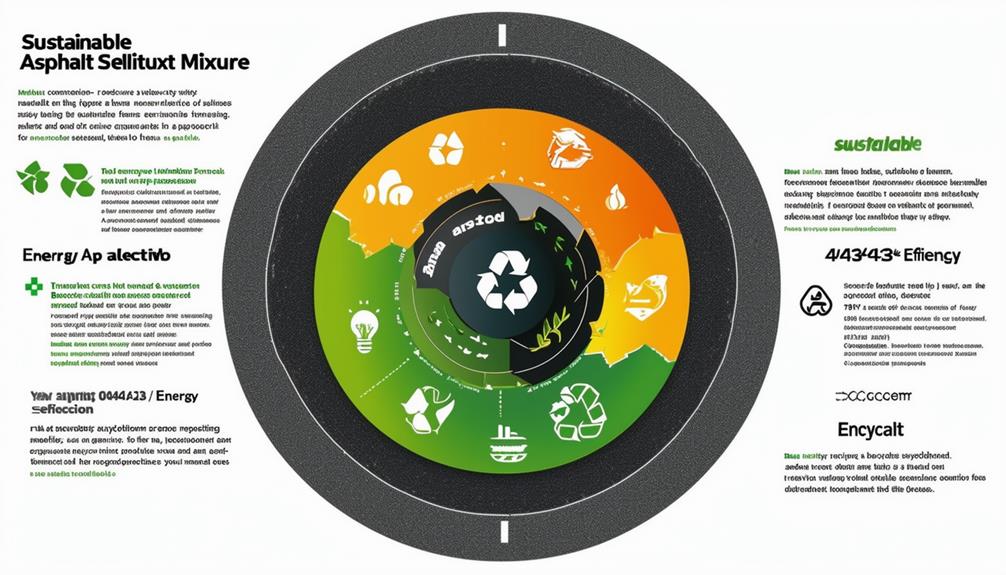
Your dedication to eco-conscious construction methodologies necessitates a comprehensive analysis of the enduring sustainability of the asphalt mixture you select. Sustainability in asphalt selection encompasses assessing environmental impact, economic feasibility, and long-term durability.
Opting for recycled asphalt mixtures substantially diminishes the demand for virgin materials and curtails waste generation. Such sustainable asphalt solutions contribute to a reduced carbon footprint and endorse eco-friendly construction initiatives.
Incorporating reclaimed asphalt pavement (RAP) in mix formulations can significantly lower both energy utilization and greenhouse gas emissions. Choosing environmentally sustainable asphalt compositions is in harmony with established green building protocols and enriches the overall sustainability of the project.
Essential Asphalt Mix Types
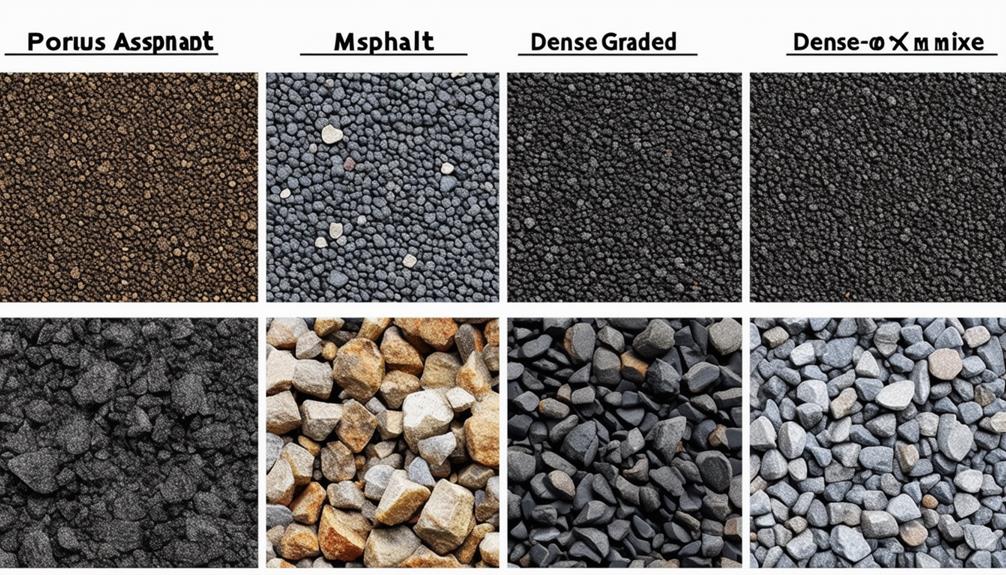
By comprehending the distinct properties of hot mix asphalt (HMA), warm mix asphalt (WMA), and cold mix asphalt (CMA), you can determine the most appropriate mix for your construction venture, guaranteeing optimal performance and ecological sustainability.
For robust pavement solutions, HMA stands as a preferred choice, frequently utilized by construction professionals. It's crafted at elevated temperatures (280-325°F) and is ideally suited for warmer climatic conditions.
In pursuit of more environmentally friendly options, WMA serves as a viable alternative. Produced at reduced temperatures (200-250°F), this mix diminishes fumes, lowers energy demands, and cuts down on greenhouse gas emissions, currently being chosen for approximately 30% of paving undertakings.
Conversely, CMA, which is designed to be stored and applied at ambient temperatures, is fitting for less-trafficked areas and excels in applications like patchwork and pothole repairs. Although it lacks the strength of HMA, advancements in CMA technology are enhancing its capabilities continuously.
Balancing Cost and Performance
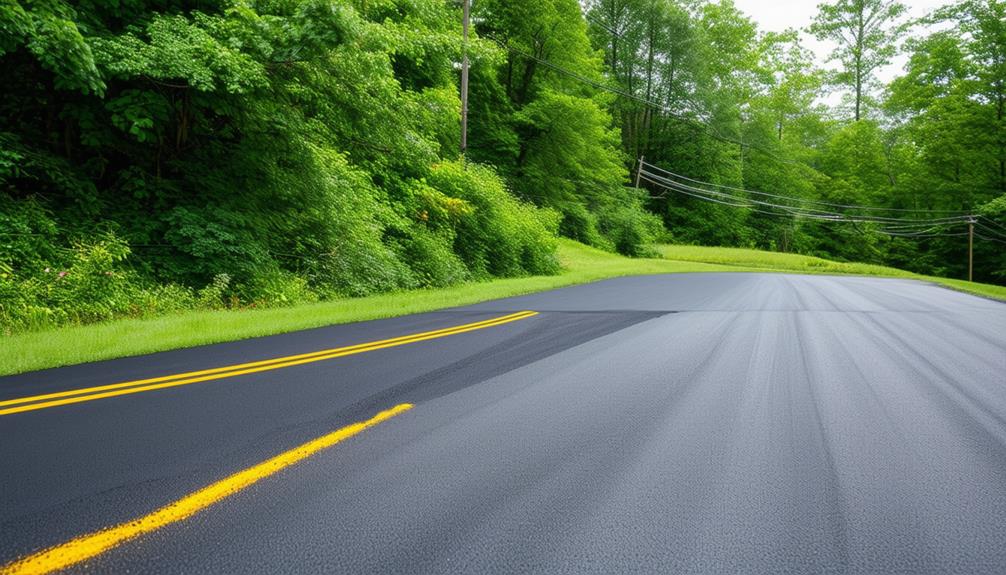
For your construction project in Troy, NY, selecting the optimal asphalt mixture involves a strategic equilibrium of expense and efficiency, aimed at reaching the required robustness and ecological sustainability within the parameters of your financial limits. In determining this equilibrium, it's essential to analyze the cost implications of various mixtures relative to their functionality, taking into account variables such as the intent and geographical specifics of the project.
For instance, when revamping a parking area, you may prefer a formulation that mitigates water impairment while maintaining economic viability.
Incorporating recycled asphalt mixtures or reclaimed asphalt pavement (RAP) serves as an eco-friendly and economical alternative. These mixtures curtail the necessity for virgin materials, thereby reducing costs without compromising on the quality of performance. These recycled mixes can also be customized to satisfy distinctive performance standards such as traction and surface evenness.
Delving into advanced-performance solutions such as Stone Matrix Asphalt (SMA) or porous asphalt might be advisable for projects that necessitate heightened durability. By proactively collaborating with engineers and material providers, you can ensure the selection of the most suitable asphalt mixture for your project, fulfilling both budgetary and performance criteria.
Avoiding Common Mix Mistakes
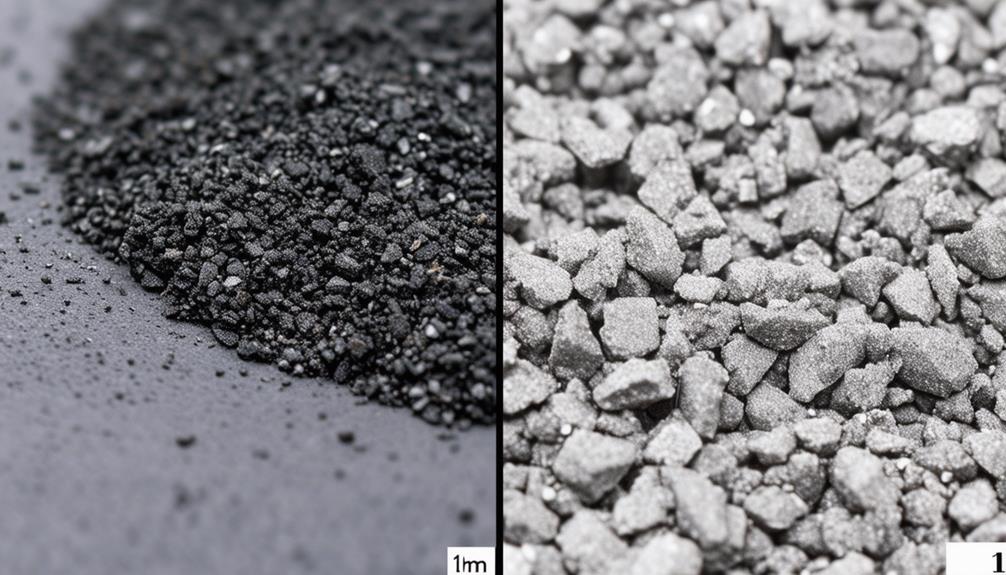
Selecting inappropriate asphalt mixes can significantly compromise the longevity of your pavement installations, thereby stressing the importance of circumventing prevalent mixture blunders. As you orchestrate your endeavor in Troy, NY, it's crucial to recognize that the optimal asphalt mix is contingent upon the distinct demands of your project. Engaging with seasoned contractors can facilitate the acquisition of the most suitable mix for its designated function.
Frequent mixing errors can catalyze the premature degradation of asphalt pavement. For example, employing a mix characterized by low penetration asphalt, fine aggregate, or absorptive aggregates can precipitate complications. Moreover, failing to adequately compact or cure the asphalt can also result in substandard performance.
When engineers and project supervisors invest effort into investigating and choosing the correct asphalt binder and additional ingredients, they can bolster the long-term efficacy of the asphalt. Evading commonplace mixing mistakes necessitates a profound comprehension of the interplay between different variables and their impact on the finished product.
Selecting for Long-Term Durability
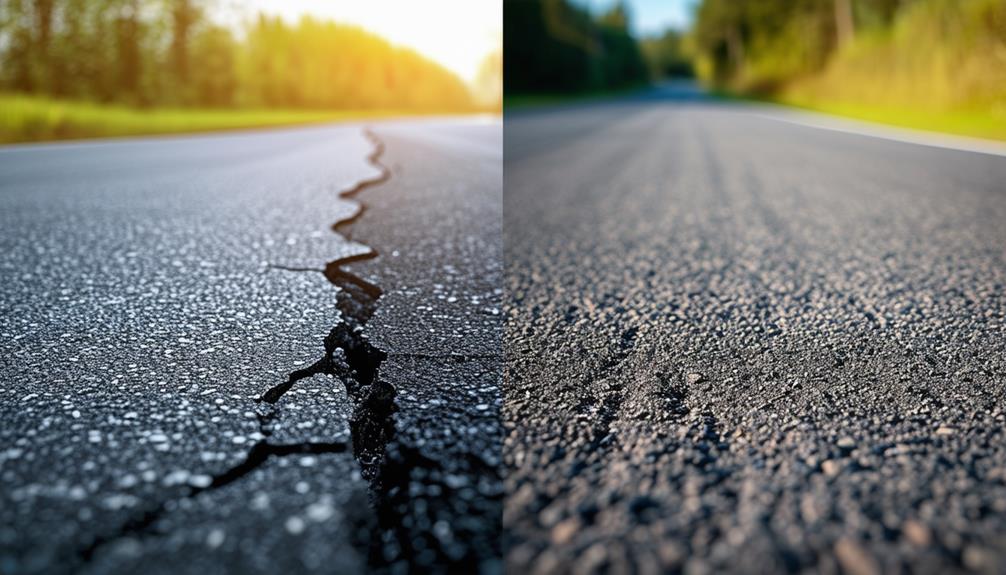
In the city of Troy, New York, selecting the ideal asphalt composition for long-term resilience necessitates an assessment of particular project demands and performance criteria, thereby ensuring that the pavement meets its intended purposes over the expected lifespan. This meticulous strategy helps circumvent prevalent pitfalls and secures the maximal longevity of your financial input.
For areas subjected to high traffic stress, such as city intersections, the incorporation of Stone Matrix Asphalt (SMA) is recommended due to its superior durability characteristics.
Conversely, for applications like parking lots and residential driveways, Porous Asphalt is advisable as it provides enhanced longevity and efficient hydrological management.
In the domain of residential avenues and commercial parking spaces, Warm Mix Asphalt (WMA) is endorsed for its sustainable and enduring performance, which also significantly reduces emissions and energy requirements.
Additionally, the advantages of utilizing recycled asphalt compositions shouldn't be underestimated. These budget-friendly alternatives not only maintain fiscal constraints but also contribute to the sustainable lifecycle of the pavement.
Frequently Asked Questions
How Do I Figure Out How Much Asphalt I Need?
To determine the quantity of asphalt necessary, commence by calculating the surface area to be paved. This is achieved by multiplying the length and width in feet.
Subsequently, assess the desired asphalt thickness, which will depend on the intended use of the pavement. Utilize a mathematical formula to transform these dimensions into cubic feet and subsequently into tons.
It's crucial to account for elements like compaction and waste in your calculations to ensure accuracy. Consulting with professional suppliers or contractors is advisable to receive tailored advice that aligns with your financial constraints and the specifics of your project.
What Is the Difference Between SP 9.5 and 12.5 Asphalt Mix?
When selecting between SP 9.5 and SP 12.5 asphalt mixes for your construction project, it's crucial to assess several variables that can substantially influence the outcome. Durability is a paramount concern; typically, SP 9.5 mixes offer enhanced durability.
The performance under various temperature ranges is also critical, with SP 12.5 mixes exhibiting superior adaptability in extreme conditions. Analyze both financial implications and logistical aspects such as project scale, ongoing maintenance demands, and the ecological footprint.
Additionally, consider the ability of the asphalt to withstand diverse weather conditions. By thoroughly evaluating these parameters, you can determine the most suitable asphalt mix for your specific requirements.
What Is the Most Commonly Used Asphalt Mix?
In the realm of asphalt construction, when opting for the appropriate asphalt mixture for your specific project, it's critical to take into account a variety of determinants.
The predominant choice among these is Hot Mix Asphalt (HMA), renowned for its robust durability and optimal performance during the warmer seasons.
Complementing this are other formulations such as Warm Mix Asphalt (WMA), preferred for its ecological advantages, Cold Mix Asphalt (CMA), utilized primarily for repair and patchwork applications, and Stone Matrix Asphalt (SMA), designed for regions subjected to intense traffic and high-stress conditions.
What Grade of Asphalt Is Best for a Driveway?
To optimize the longevity of your driveway, take into account elements such as local climate conditions, the intensity of vehicular movement, and budgetary constraints.
In Troy, NY, employing dense-graded asphalt mixtures, which feature a comprehensive distribution of aggregate sizes and an increased amount of binder, proves beneficial for driveways subjected to frequent vehicular usage.
Engage with experienced contractors in your vicinity to customize the asphalt formulation to align with the specific requirements of your project and financial considerations.
Conclusion
Selecting the appropriate asphalt mixture in Troy, NY necessitates an analysis of various elements including local climate conditions, levels of vehicular traffic, and budget constraints.
It's crucial to assess the nature of the deployment project along with necessary performance attributes, such as resistance to rutting and capacity to withstand thermal cracking.
Further, integrating sustainability considerations is important.
By judiciously weighing financial implications against performance benefits, you can achieve extended durability and functionality in your asphalt installations.
